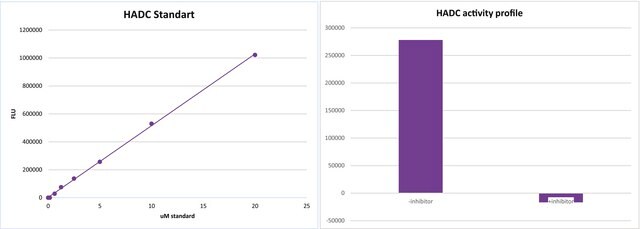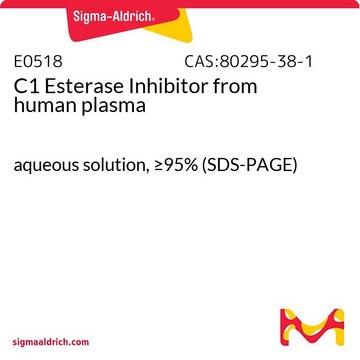EPI003
In Situ Histone Deacetylase (HDAC) Activity Fluorometric Assay Kit
100 assays in 96 well plates
Anmeldenzur Ansicht organisationsspezifischer und vertraglich vereinbarter Preise
Alle Fotos(1)
About This Item
Empfohlene Produkte
Verwendung
100 assays in 96 well plates
Versandbedingung
wet ice
Lagertemp.
−20°C
Allgemeine Beschreibung
Histone deacetylases (HDACs) are a large family of enzymes that remove acetyl groups from histone proteins. HDACs are localized in both the cytosol and nucleus and some shuttle between the two locations.
Sigma′s InSitu HDAC Activity Fluorometric Assay Kit provides a direct, fast, fluorescence-based method to measure HDAC activity in cultured cells. The procedure requires just two steps, both performed in the original 96-well cell culture plate. First, the cell culture medium is replaced with a cell permeable HDAC Substrate, containing an acetylated lysine side chain. During the subsequent incubation, HDAC Substrate enters the cells and is deacetylated by intracellular HDAC. In the second step, Developer is added to lyse the cells and cleave the deacetylated HDAC Substrate to release a fluorophore. The fluorescence generated can be quantified at Ex/Em = 368/442 nm. The assay is well suited for either individual or high throughput screening.
Sigma′s InSitu HDAC Activity Fluorometric Assay Kit provides a direct, fast, fluorescence-based method to measure HDAC activity in cultured cells. The procedure requires just two steps, both performed in the original 96-well cell culture plate. First, the cell culture medium is replaced with a cell permeable HDAC Substrate, containing an acetylated lysine side chain. During the subsequent incubation, HDAC Substrate enters the cells and is deacetylated by intracellular HDAC. In the second step, Developer is added to lyse the cells and cleave the deacetylated HDAC Substrate to release a fluorophore. The fluorescence generated can be quantified at Ex/Em = 368/442 nm. The assay is well suited for either individual or high throughput screening.
Anwendung
In Situ Histone Deacetylase (HDAC) Activity Fluorometric Assay Kit has been used to determine HDAC activity.
Biochem./physiol. Wirkung
Site specific histone acetylation and deacetylation have been shown to activate or repress eukaryotic gene transcription, respectively, and as a consequence, histone deacetylases (HDACs) play a crucial role in organism development and disease. Mutation or abnormal expression of HDAC is observed in cancer.
Leistungsmerkmale und Vorteile
- Simple two-step sensitive and reliable assay
- All steps performed in the same cell culture plate
- Utilizes fluorometric method
- Sample type: cultured, adherent, and suspension cells
- Suitable for individual tests or high throughput assays and kinetic studies
- Convenient 96-well microplate format
- Suitable for screening HDAC inhibitors or activators
- Suitable for studying growth factors or other regulators that influence HDAC activity
Ähnliches Produkt
Produkt-Nr.
Beschreibung
Preisangaben
Signalwort
Warning
H-Sätze
Gefahreneinstufungen
Aquatic Chronic 3 - Eye Irrit. 2
Lagerklassenschlüssel
10 - Combustible liquids
WGK
WGK 3
Flammpunkt (°F)
188.6 °F - closed cup
Flammpunkt (°C)
87 °C - closed cup
Analysenzertifikate (COA)
Suchen Sie nach Analysenzertifikate (COA), indem Sie die Lot-/Chargennummer des Produkts eingeben. Lot- und Chargennummern sind auf dem Produktetikett hinter den Wörtern ‘Lot’ oder ‘Batch’ (Lot oder Charge) zu finden.
Besitzen Sie dieses Produkt bereits?
In der Dokumentenbibliothek finden Sie die Dokumentation zu den Produkten, die Sie kürzlich erworben haben.
Covalent modifications of histones during development and disease pathogenesis.
Bhaumik S R, et al.
Nature Structural and Molecular Biology, 14(11), 1008-1008 (2007)
The biology of HDAC in cancer: the nuclear and epigenetic components.
Handbook of Experimental Pharmacology, 206, 13-37 (2011)
Targeting histone deacetylase activity to arrest cell growth and promote neural differentiation in Ewing sarcoma.
Souza B K, et al.
Molecular Neurobiology, 1-17 (2018)
Christina Stache et al.
Neurosurgical focus, 41(6), E14-E14 (2016-12-03)
OBJECTIVE In this study, the authors investigated the underlying mechanisms responsible for high tumor recurrence rates of adamantinomatous craniopharyngioma (ACP) after radiotherapy and developed new targeted treatment protocols to minimize recurrence. ACPs are characterized by the activation of the receptor
Long Jin et al.
Theriogenology, 87, 298-305 (2016-10-16)
Cloning remains as an important technique to enhance the reconstitution and distribution of animal population with high-genetic merit. One of the major detrimental factors of this technique is the abnormal epigenetic modifications. MGCD0103 is known as a histone deacetylase inhibitor.
Unser Team von Wissenschaftlern verfügt über Erfahrung in allen Forschungsbereichen einschließlich Life Science, Materialwissenschaften, chemischer Synthese, Chromatographie, Analytik und vielen mehr..
Setzen Sie sich mit dem technischen Dienst in Verbindung.







